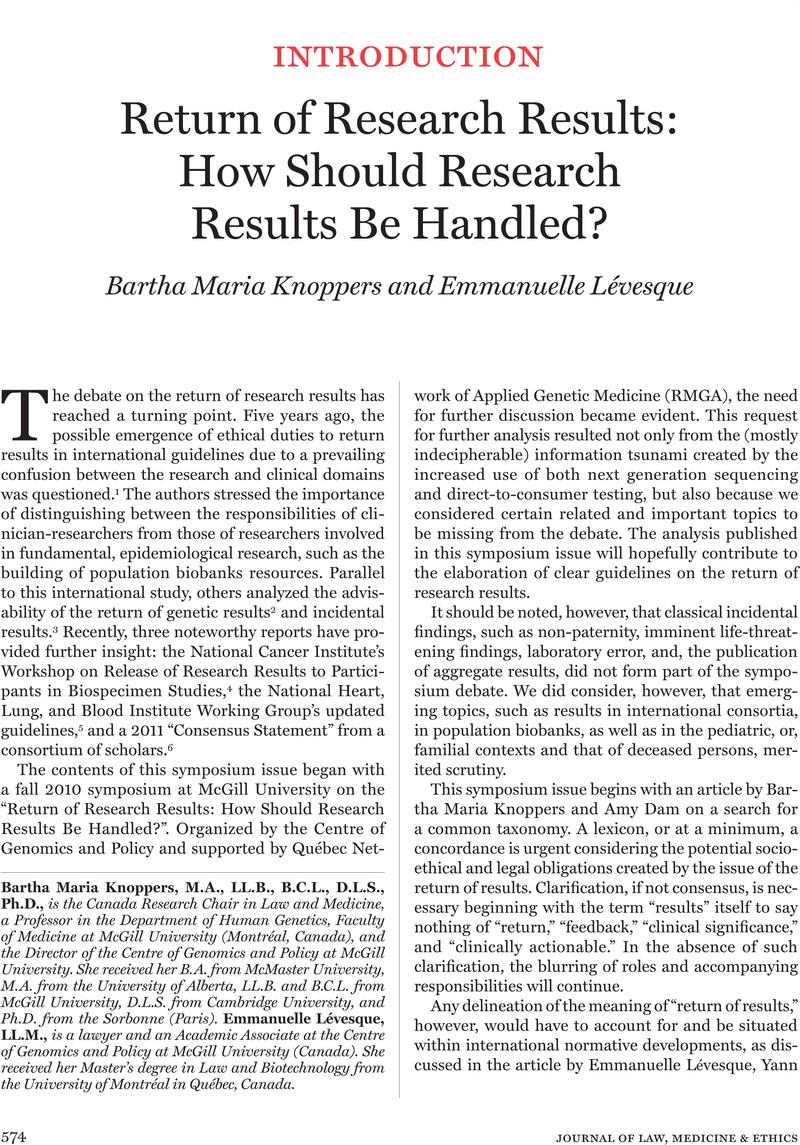Crossref Citations
This article has been cited by the following publications. This list is generated based on data provided by Crossref.
Thorogood, A
Knoppers, BM
Dondorp, WJ
and
de Wert, GMWR
2012.
Whole‐genome sequencing and the physician.
Clinical Genetics,
Vol. 81,
Issue. 6,
p.
511.
Knoppers, Bartha Maria
Deschênes, Mylène
Zawati, Ma’n H
and
Tassé, Anne Marie
2013.
Population studies: return of research results and incidental findings Policy Statement.
European Journal of Human Genetics,
Vol. 21,
Issue. 3,
p.
245.
Knoppers, Bartha Maria
Rioux, Amélie
and
Zawati, Ma‘n H
2013.
Pediatric Research ‘Personalized‘? International Perspectives on the Return of Results.
Personalized Medicine,
Vol. 10,
Issue. 1,
p.
89.
Shaibi, Gabriel Q.
Coletta, Dawn K.
Vital, Veronica
and
Mandarino, Lawrence J.
2013.
The Design and Conduct of a Community‐Based Registry and Biorepository: A Focus on Cardiometabolic Health in Latinos.
Clinical and Translational Science,
Vol. 6,
Issue. 6,
p.
429.
Saeed, Sara
Golfam, Mohammad
Beall, Reed F.
Ashbury, Fredrick D.
Palmer, Lyle J.
and
Little, Julian
2014.
Effectiveness of individual‐focused interventions to prevent chronic disease.
European Journal of Clinical Investigation,
Vol. 44,
Issue. 9,
p.
882.
Edwards, Karen L.
Korngiebel, Diane M.
Pfeifer, Lesley
Goodman, Deborah
Renz, Anne
Wenzel, Lari
Bowen, Deborah J.
and
Condit, Celeste M.
2016.
Participant views on consent in cancer genetics research: preparing for the precision medicine era.
Journal of Community Genetics,
Vol. 7,
Issue. 2,
p.
133.
Holm, Ingrid A.
2017.
Pediatric Issues in Return of Results and Incidental Findings: Weighing Autonomy and Best Interests.
Genetic Testing and Molecular Biomarkers,
Vol. 21,
Issue. 3,
p.
155.
Zulu, Victor Chisha
Syakalima, Michelo
and
Ali, Joseph
2022.
Ethical dimensions of zoonotic disease research: Perspectives of traditional livestock keepers in Zambia.
Wellcome Open Research,
Vol. 7,
Issue. ,
p.
201.
Zulu, Victor Chisha
Syakalima, Michelo
and
Ali, Joseph
2023.
Ethical dimensions of zoonotic disease research: Perspectives of traditional livestock keepers in Zambia.
Wellcome Open Research,
Vol. 7,
Issue. ,
p.
201.



